At the ranger station for the San Gorgonio district, they gave us several options, all of which sounded good. Eventually, we decided on a 4.8-mile hike with 3200 feet of elevation gain, to a campground on High Creek. The campground was at 9200’, so the ranger warned us to expect temperatures in the low 20s. Brr! 9200’ is only a few hundred feet lower than where we lived all winter, but that was in a house, not a tent!
After packing our bags, including lots of warm clothes, we started on our way. It was great weather for hiking – not too hot, not too cold. We followed a road for a little ways and then crossed a creek that afforded great mountain views:
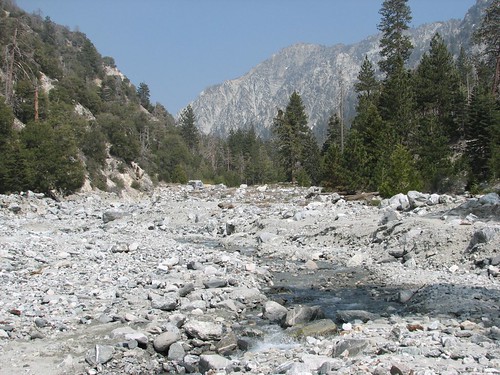
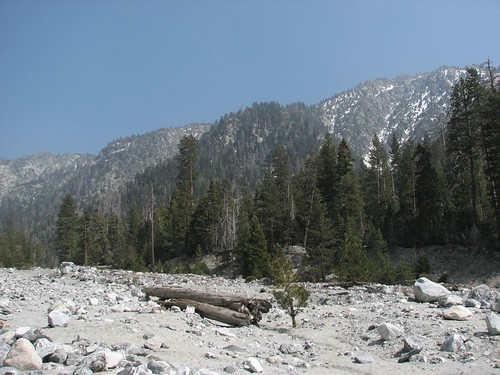
Our desert adventures had been a lot of fun, but we agreed that while the desert was a beautiful place to visit, it wasn’t a place we could ever call home. We feel a lot more at home in the mountains.
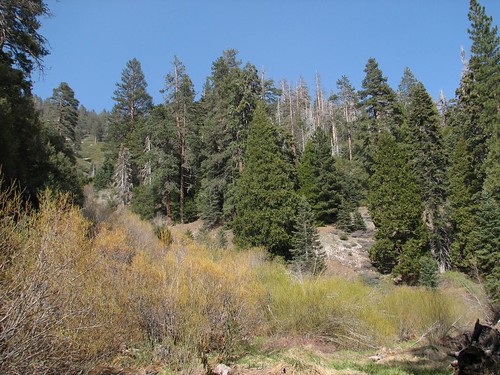
From a distance, these mountains could have been in the Northwest, but close up, certain aspects were wrong. To start with, the pinecones were way too big – bigger than Sarah’s hand.
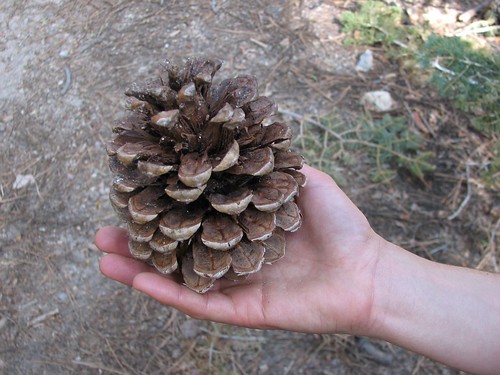
But these mountains also had a touch of the desert. Yuccas were common, as were lizards. These weren’t full-sized lizards like we’d seen in the deserts. They were much smaller, almost like their growth had been stunted by living in the mountains and not being able to bask in 90-degree sunshine every day. Further up on the hike, we saw a lot of manzanita, a really interesting plant that has lots of gray, dead branches with live orange branches mixed in, and sometimes even growing over the gray branches.
Despite the differences from home, it felt good to be hiking in the mountains again. After the first creek crossing, we climbed steeply for a mile to the boundary of the wilderness. At that point, the slope became gentler as the hike followed Vivian Creek for about 1.5 miles. We’d been following the creek for a while, enjoying the trees all around and the sound of the water, when we came face to face with this guy:

The bear was on the opposite side of the creek from us, maybe twenty yards away, but it looked huge! Quite a healthy adult bear. And when Brian, who was in the lead, saw it, it was looking right back – clearly, the bear had seen us before we noticed it. The creek was surrounded by a lot of vegetation, so we’d gotten much closer to the bear than we would have liked before noticing it.
We’ve seen maybe a dozen bears while hiking, and every bear has displayed one of two behaviors: Either it runs away from us in fear, or it ignores us, continuing to do its own thing. This bear looked at us for a few seconds and then started walking down the creek, parallel to the trail. Brian took one more picture:
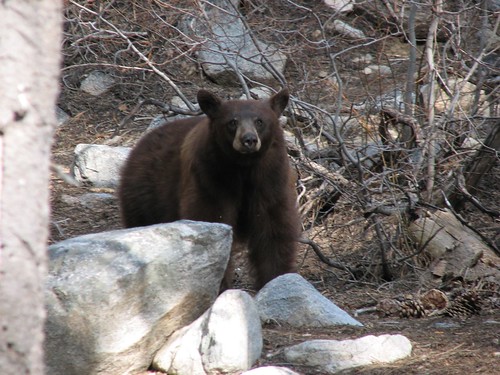
The bear seemed to be ignoring us, so even though it was too close for comfort, we continued on up the trail, expecting that we and the bear would pass each other, and that would be the end of it.
Wrong. We walked up the trail a short ways and then were surprised to find that the trail crossed the creek. To the bear’s side. We’d lost sight of the bear due to the vegetation but had every reason to expect that it had continued down the creek, so we went around the bend in the trail to cross the creek. There was the bear, no more than fifteen yards away, right across the creek and practically on the trail! It had clearly changed its mind about going down the creek and instead had come back up the creek to meet us.
This behavior was a bit worrisome. There was only one thing for us to do – back away from the bear slowly, try not to disturb it, and head back down the trail. We should have been talking loudly to it as well, but we were spooked by the bear’s behavior and forgot our “bears in the wilderness” rules. The bear may not have heard us anyway – the creek was pretty loud, and thankfully, it still separated us.
So we headed down the trail perhaps 200 yards before coming to a very large boulder. This seemed like a good spot to hang out, so we sat on the rock, keeping our packs on in case the bear returned and we needed to make a getaway. We sat there for about ten minutes without seeing the bear and were just about to get up and resume our hike when the bear returned. Now, instead of being on the opposite side of the creek, it was right in the bottom of the creek drainage, but it was still a fair distance away. Having regained our wits during our wait on the boulder, we started talking loudly and firmly to the bear, telling it not to approach, to go away, etc.
It didn’t listen. It looked up at us, then continued down the drainage. We hoped it would pass us by, but no luck. After the bear had taken a few steps, it was quite clear that it wasn’t just walking down the drainage – it was headed straight toward us. We continued to talk to it, but as it continued heading toward us, we backed away, climbing up a hill on the side of the trail that was sparsely covered in some low vegetation. The bear continued toward us, and we continued up the hill, away from the bear, continuing to tell it to go away but losing hope that it would.
When the bear reached the boulder that we’d been sitting on, it hung around there for a while, sniffing. We’d clearly left our scent on the boulder. And disturbingly, the bear was clearly interested. At this point, the bear’s behavior no longer fit into one of the two behavioral profiles we’d encountered before. This bear wasn’t running from us, and it wasn’t ignoring us. It was stalking us. “Stalking” is the best word we can come up with – the bear wasn’t charging us, and it didn’t seem to be in any hurry. It just moved slowly, steadily, noiselessly toward us. Backing carefully away up the slope, we had no problem maintaining and even increasing the distance between us and the bear, given its current pace. Of course, there was no telling when it would step up the pace.
When the bear stopped at the boulder, we stopped, too, on the hillside, continuing to talk to the bear. Eventually, the bear stopped sniffing and looked up at us. We continued to tell it to go away, and it continued to ignore us. Instead, it started up the slope, following the exact path we’d followed. Still stalking us. At this point we were scared, and we resumed our careful retreat, this time a bit more hastily.
At this point, the bear was down the trail from us, so the easiest thing for us to do was to continue along the hillside, rejoining the trail above the boulder, closer to where we’d first met the bear. The vegetation was thicker here than on the trail, so it wasn’t long before we lost sight of the bear. There was nothing for us to do but continue quickly across the hillside, back to the trail. Back on the trail, we continued to the point where it turned across the creek, looking back frequently for the bear and not seeing it. We crossed the creek – still no sign of the bear.
Just after the creek crossing, we came to a backcountry campground where we’d been considering staying. We definitely weren’t staying there now, so we continued past without breaking stride. We also continued to make noise – we didn’t know if there were other bears where that one came from, but if there were, we didn’t want to startle them.
The trail continued to move away form the creek, and we kept following it, still looking behind us every so often, dreading and almost expecting to see the bear right behind us. But we never saw it. After about an hour of hiking uphill at a pretty fast clip without stopping even for a sip of water, we finally took a break. We tried to convince each other that the bear wouldn’t follow us this far, but we still didn’t stop for long.
After this break, we did take a couple of pictures. The hike was quite beautiful, and it would have been a shame to completely miss the scenery because we’d been spooked by a bear. The mountains opposite us still had a lot of snow:

We also saw a small waterfall a ways below us:
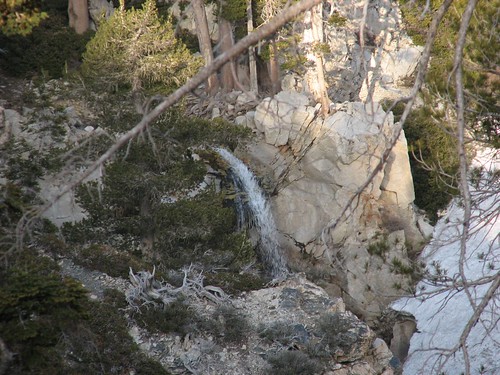
We’ll never know if the bear gave up the chase on the hillside, or if it continued to stalk us for a mile, staying just out of sight the whole way, but to make a long story short, we made it to our campground without seeing it again.
As you might expect, the bear’s strange behavior was a topic of lengthy discussion, and we came up with three possible explanations. The most gruesome possibility was that the bear was stalking us because it wanted to eat us. This didn’t make much sense, though. Black bears don’t hunt humans unless they’re really desperate – sick and starving, usually. This bear was quite healthy – clearly not starving.
The next explanation was that the bear was just curious. It was in a wilderness area after all, where it’s protected, so maybe it just never learned to fear humans. This also didn’t make a lot of sense either. Sheer curiosity might be a motivation for a juvenile bear, but this one was on the very large end of the range of black bears that we’d seen – pretty clearly an adult. It seemed pretty unlikely that a full-grown bear would stalk us out of nothing more than curiosity.
This left us with the most likely possibility: The bear had come to associate people with food. It smelled us and decided that we were a food source, so it came cautiously after us, perhaps expecting that we might be scared enough to drop our packs and leave it a tasty meal. The fact that we’d met the bear just below a backcountry campground supported the theory – the bear might have gotten into some backpackers’ food at the camp.
Regardless of the explanation, though, we were still pretty freaked out, and made sure to hang our food very carefully from a tree. We typically just throw a rope over a tree branch, tie our food bag to the rope, hoist the bag up to the branch, and tie the rope to a tree. The rangers had recommended against this, though, saying that the bears have learned to cut the rope with their teeth and claws. Instead, they recommend counterbalancing – dividing your food into two separate bags of equal weight, and hoisting them up to equal height so that no rope hangs down for the bear to break. Given our experience, we followed the rangers’ instructions. We didn’t hang just our food either; we hung our entire packs.
The next morning, after a fitful night’s sleep repeatedly interrupted by bear nightmares, Sarah got out of the tent first and looked at the tree where we’d hung our packs. They weren’t there! Brian started scrambling to get out of the tent, but Sarah then realized that she just couldn’t see the packs from her viewpoint. After she moved a little ways, she could see them, still hanging safely in the tree, out of reach of critters. We pulled them down and were relieved to see that they were undisturbed.
Today was Friday, so we expected to see other hikers coming up the trail. Wanting those other hikers to be the first of the day to pass the spot where we’d seen the bear, we took our time with breakfast and then lounged around camp, reading books. Around 10:30 in the morning, we met the first couple of hikers of the day. We related our bear story and asked if they’d seen any bears. They said they hadn’t. Relieved, we packed up camp and headed on our way down the trail.
We met several other hikers, but no one had seen a bear. And sure enough, when we reached the spot where the bear had been the previous day, there was nothing now. We walked along the creek quickly, worried that the bear might still be somewhere along the creek, but we never saw it.
We left the creek with relief and started down the steep switchbacks. We’d noticed the previous day that the smog was bad, but today it was even worse – we could hardly see even nearby mountains.
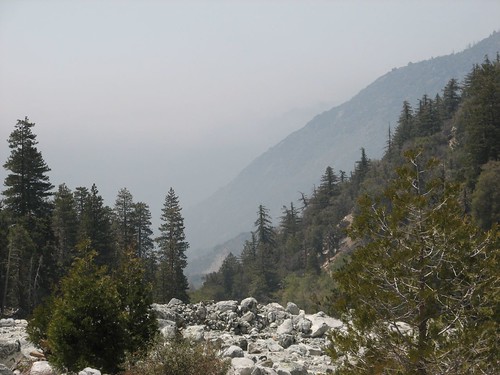
We made it back to the parking lot and started unpacking when someone dropped by and let us know that there were bighorn sheep on the side of the creek. So after unpacking, we headed over there and caught a glimpse of them before they headed away:


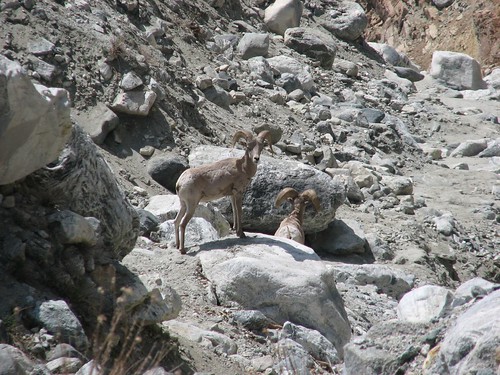
After that, we headed off. We stopped at the ranger station to tell them about the bear incident, thinking that at the very least, they’d want to close the campground where the bear was hanging around. As we were telling our story, the ranger said that it must have gotten into backpackers’ food at some point, confirming our opinion.
After we finished our story, the ranger was amazingly nonchalant. She said that it was alarming, but they’ve had worse: Some bears will actually bluff charge backpackers, hoping to freak out the backpackers so that they drop their packs and run. As for what to do about the bear, they said they couldn’t really relocate it because bears are smart enough that even if you relocate them hundreds of miles away, they’ll find their way back within days. And there’s not really a good place to relocate them to anyway – after all, bears in this area are descended from problem bears from Yellowstone that were relocated here. Finally, the rangers said they couldn’t even tell the fish and game division about the bear’s behavior because if they did, the bear would likely be killed. The best they could do would be to advise future backpackers of the bear activity near the campground.
It was really an enjoyable backpacking trip with beautiful scenery, except for that unsettling bear. Oh well, on to Los Angeles!
No comments:
Post a Comment